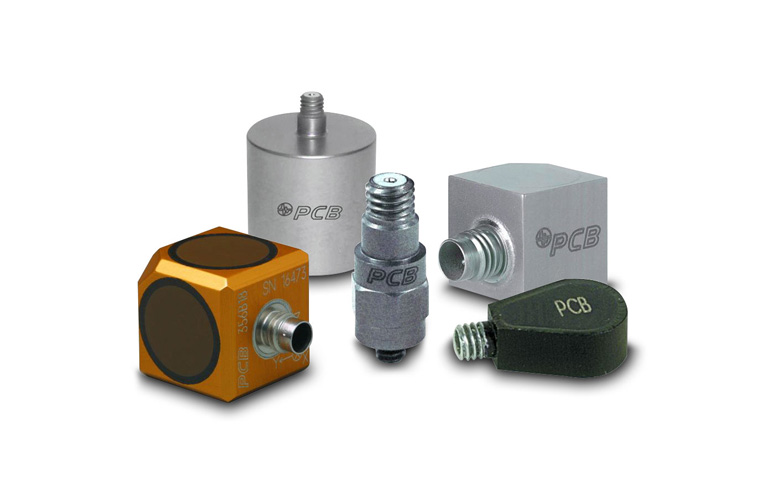Main Menu
- Home
- Product Finder
- Calibration Systems
- Calibration Services
- Digital Sensing
- Industrial Vibration Calibration
- Modal and Vibration Testing
- Non-Destructive Testing
- Sound & Vibration Rental Program
- Learn
- About Us
- Contact Us
 Piezoelectric sensors are widely accepted for their excellent output linearity and dynamic response. As sensor users, it is important to understand the core principles of piezoelectricity, the fundamental advantages and disadvantages of piezoelectric sensors, as well as the basics of signal conditioning designs.
Piezoelectric sensors are widely accepted for their excellent output linearity and dynamic response. As sensor users, it is important to understand the core principles of piezoelectricity, the fundamental advantages and disadvantages of piezoelectric sensors, as well as the basics of signal conditioning designs.
Piezoelectricity is the collection or flow of electrons on opposite sides of a material due to the application of a mechanical stress on the material. In other words, piezoelectric materials generate electricity when they are squeezed.
Piezoelectric materials allow us to build sensors that:
While piezoelectric sensors hold the aforementioned advantages over other sensor technologies, some of the disadvantages are:
High impedance signals can be difficult to work with when trying to make precise measurements as such an electrical signal is easily susceptible to many different kinds of noise. This is often bad for our measurement. We will look more in depth at how to condition this high impedance output signal so it can be measured effectively. We call this "signal conditioning."
Generally speaking, we convert the high impedance source of a piezoelectric material to a lower impedance signal by using an electrical amplifier. Many different amplifier designs (more details here, see Section 2 on Page 4 of the PDF) exist, but it is enough for this article to describe this amplifier by saying it requires external power, and it doesn’t have the wide operating temperature range of the piezoelectric material. Of course, the other thing to consider is that the amplifier has a low impedance output signal that is not as susceptible to noise and is very easily measured.
The measurement community has settled on two basic configurations for inserting this amplifier into the measurement: ICP® and charge mode.
ICP® (or IEPE) sensors place the amplifier as close to the piezoelectric material as possible. The amplifier is integrated into the sensor itself. This may be remembered by associating the "I" in ICP® and IEPE with the word "Integrated." In fact, the "I" stands for “Integrated Circuit PiezoElectric” and “Integrated Electronics, PiezoElectric.”
This integration has the following major effects: it reduces the inherent noise on the signal to an absolute minimum, simplifies the design of the amplifier and provides a low-impedance output signal, which is less susceptible to signal degradation.
The amplifier simplification is done, in part, by necessity. The sensor’s overall utility is increased by making it as small and lightweight as possible. An amplifier design that is physically large or complex is not acceptable. These amplifiers have a fixed gain and sometimes fixed low pass filtering of a very simple design.
This simplicity has many collateral benefits, including ease of use and elimination of operator error. Once the amplifier is sealed inside the sensor, uncertainty regarding the gain or filter setting is removed, as it cannot be adjusted.
However, this integrated amplifier also inherently limits the temperature range of the sensor to typically -65 °F to 325 °F (-54 °C to 163 °C).
Charge Mode Operation implements the amplifier circuit outside of the sensor at a remote location physically removed from the sensor. This extends the high impedance circuit over a range of up to dozens of meters and, only then, does the amplifier convert the signal.
Operating temperatures are commonly reached from -95 °F to 1000 °F
(-71 °C to 538 °C). Specialized sensors have even wider operating temperature ranges.
This physical separation allows for a more complex amplifier design, sometimes with complex filtering and finely adjustable gain. It expands the utility of the sensor to the full range of applications supported by the piezoelectric element: both the lowest and highest levels can be measured by adjusting the gain and both high and low pass filters may be implemented.
However, with this complexity comes the opportunity for operational errors. Tedious adjustments need to be made to the gain and filtering and documented for future reference. These same adjustments require compensation when converting the electrical voltage units to mechanical acceleration units. Furthermore, the expanded dynamic range one may attain is not fully realized due to the fact that the amplifier will gain both noise and signal at higher levels. The potential for noise at the input of the amplifier is further increased due to the extended length of high impedance cabling. All of this is for the purpose of extending the dynamic range of the sensor, the limits of which are rarely pushed in a measurement application.
For these reasons, test engineers frequently decide to simply use a second ICP® accelerometer with a different measurement range. This extends the amplitude range of the lab’s capability, allows confident and simple operation, and is done so at a lower cost than implementing a complex charge amplifier.